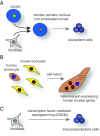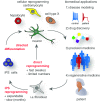The novel tool of cell reprogramming for applications in molecular medicine
- PMID: 28597071
- PMCID: PMC5487694
- DOI: 10.1007/s00109-017-1550-4
The novel tool of cell reprogramming for applications in molecular medicine
Abstract
Recent discoveries in the field of stem cell biology have enabled scientists to "reprogram" cells from one type to another. For example, it is now possible to place adult skin or blood cells in a dish and convert them into neurons, liver, or heart cells. It is also possible to literally "rejuvenate" adult cells by reprogramming them into embryonic-like stem cells, which in turn can be differentiated into every tissue and cell type of the human body. Our ability to reprogram cell types has four main implications for medicine: (1) scientists can now take skin or blood cells from patients and convert them to other cells to study disease processes. This disease modeling approach has the advantage over animal models because it is directly based on human patient cells. (2) Reprogramming could also be used as a "clinical trial in a dish" to evaluate the general efficacy and safety of newly developed drugs on human patient cells before they would be tested in animal models or people. (3) In addition, many drugs have deleterious side effects like heart arrhythmias in only a small and unpredictable subpopulation of patients. Reprogramming could facilitate precision medicine by testing the safety of already approved drugs first on reprogrammed patient cells in a personalized manner prior to administration. For example, drugs known to sometimes cause arrhythmias could be first tested on reprogrammed heart cells from individual patients. (4) Finally, reprogramming allows the generation of new tissues that could be grafted therapeutically to regenerate lost or damaged cells.
Keywords: Cell fate; Reprogramming; Stem cell biology.
Figures



Similar articles
-
Pharmacological Reprogramming of Somatic Cells for Regenerative Medicine.Acc Chem Res. 2017 May 16;50(5):1202-1211. doi: 10.1021/acs.accounts.7b00020. Epub 2017 Apr 28. Acc Chem Res. 2017. PMID: 28453285
-
Direct cardiac reprogramming: progress and challenges in basic biology and clinical applications.Circ Res. 2015 Apr 10;116(8):1378-91. doi: 10.1161/CIRCRESAHA.116.305374. Circ Res. 2015. PMID: 25858064 Review.
-
Induced pluripotent stem cells in medicine and biology.Development. 2013 Jun;140(12):2457-61. doi: 10.1242/dev.092551. Development. 2013. PMID: 23715538
-
In Vivo Cellular Reprogramming: The Next Generation.Cell. 2016 Sep 8;166(6):1386-1396. doi: 10.1016/j.cell.2016.08.055. Cell. 2016. PMID: 27610565 Free PMC article. Review.
-
Reprogramming cancer cells: a novel approach for cancer therapy or a tool for disease-modeling?Cancer Lett. 2015 Dec 1;369(1):1-8. doi: 10.1016/j.canlet.2015.06.027. Epub 2015 Aug 11. Cancer Lett. 2015. PMID: 26276716 Review.
Cited by
-
Next-generation direct reprogramming.Front Cell Dev Biol. 2024 Feb 2;12:1343106. doi: 10.3389/fcell.2024.1343106. eCollection 2024. Front Cell Dev Biol. 2024. PMID: 38371924 Free PMC article. Review.
-
Wound healing, cellular regeneration and plasticity: the elegans way.Int J Dev Biol. 2018;62(6-7-8):491-505. doi: 10.1387/ijdb.180123sj. Int J Dev Biol. 2018. PMID: 29938761 Free PMC article. Review.
-
Transdifferentiation: a new promise for neurodegenerative diseases.Cell Death Dis. 2018 Aug 6;9(8):830. doi: 10.1038/s41419-018-0891-4. Cell Death Dis. 2018. PMID: 30082779 Free PMC article. Review.
-
Finding MyoD and lessons learned along the way.Semin Cell Dev Biol. 2017 Dec;72:3-9. doi: 10.1016/j.semcdb.2017.10.021. Epub 2017 Nov 1. Semin Cell Dev Biol. 2017. PMID: 29097153 Free PMC article. Review.
-
Combining Cell Fate Reprogramming and Protein Engineering to Study Transcription Factor Functions.Methods Mol Biol. 2021;2352:227-236. doi: 10.1007/978-1-0716-1601-7_15. Methods Mol Biol. 2021. PMID: 34324190
References
-
- Spemann H, Mangold H. Induction of embryonic primordia by implantation of organizers from a different species. 1923. Int J Dev Biol. 2001;45:13–38. - PubMed
-
- Gurdon JB. The developmental capacity of nuclei taken from intestinal epithelium cells of feeding tadpoles. J Embryol Exp Morphol. 1962;10:622–640. - PubMed
Publication types
MeSH terms
Substances
LinkOut - more resources
Full Text Sources
Other Literature Sources
Medical

